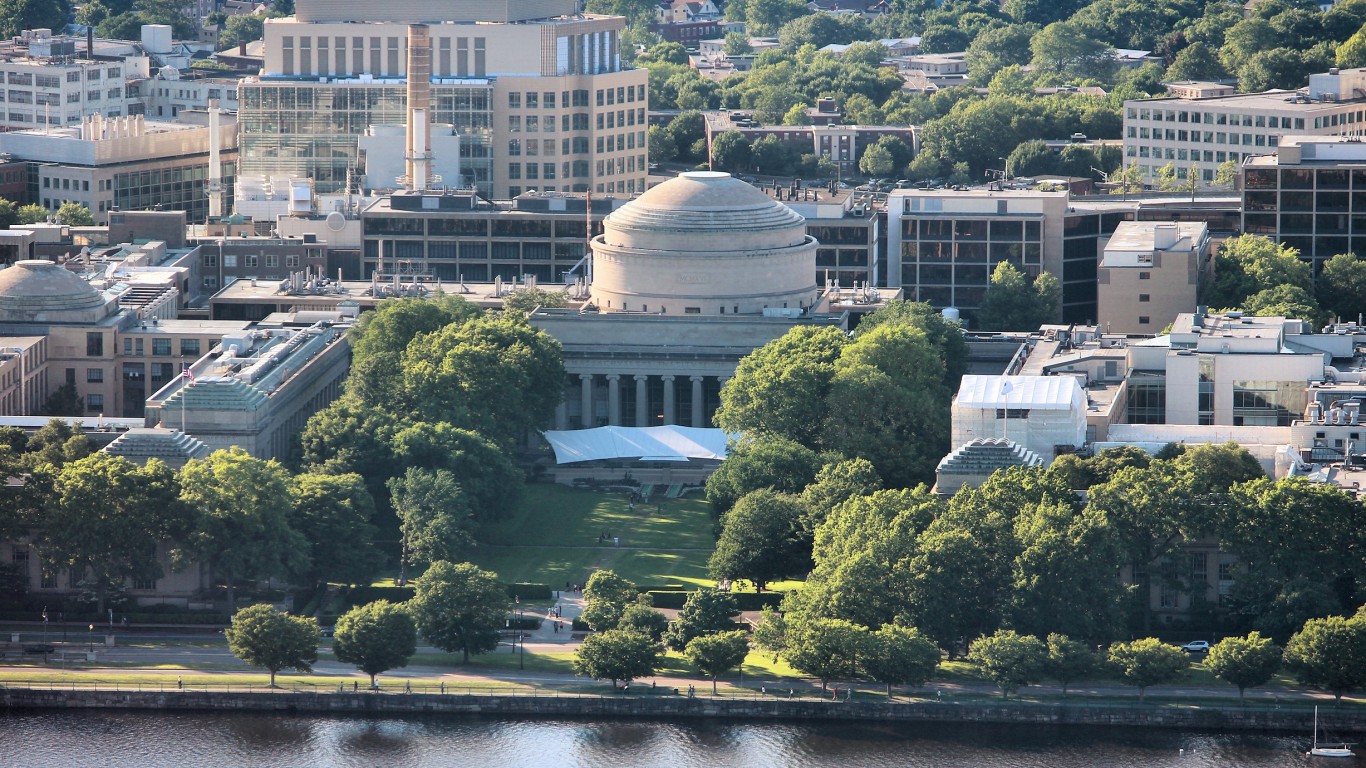
Students and teachers across the country are returning to the classroom amid a pandemic that shut down schools in much of the country for the past six months. Some teachers are quitting due to safety concerns, while others may be laid off over the next several months as state tax revenue has been decimated by the economic crisis caused by the pandemic.
There are nearly 3.1 million teachers in the United States. Though they are in charge of educating future generations, teachers in primary, middle, and secondary schools are not very well paid. The national average pay across these three levels of teaching is $64,524, and teachers in just 15 states make more than that a year.
Pay isn’t the only factor determining the quality and desirability of a teaching job. Class sizes, pensions, and general working conditions are all important when gauging what it’s like to be a teacher in a certain state. In most states, less than half of new teachers are expected to remain in the profession long enough to qualify for a pension — these are the states where teachers are paid the most and least.
To identify the states where it’s best and worst to be a teacher, 24/7 Tempo constructed an index of average annual teacher pay, student-teacher ratio, the percentage of new teachers who are expected to remain long enough in the profession to qualify for a pension, and the overall quality grade research and policy group the National Council for Teacher Quality in its 2017 annual report gave the state.
Click here for the best states to be a teacher
Click here for the worst states to be a teacher
Click here for our methodology

Best States to Be a Teacher
15. Delaware
> Average teacher pay: $65,219 (15th highest)
> Student-teacher ratio: 13.2 to 1 (21st lowest)
> New teachers expected to qualify for pension: 29.0% (8th lowest)
> Teacher employment: 9,330 (40.7% elementary, 23.6% middle, 35.7% high school)
> High school graduation rate: 86.9% (21st highest)
In its most recent 2017 evaluation of state education policy goals, The National Council on Teacher Quality (NCTQ) awarded Delaware a B+ for teacher hiring, contributing to an overall grade of B-, one of the better grades in the nation. Delaware’s public school teachers are paid fairly well compared to other states, with the average salary across elementary, middle, and secondary school levels slightly above the national average. The state’s average annual teacher salary is $65,219, the 15th highest of all states.
As the new academic year begins across the state, teachers are getting home test kits to test for COVID-19. Testing sites are made available close to schools as well.
[in-text-ad]

14. Michigan
> Average teacher pay: $66,403 (14th highest)
> Student-teacher ratio: 16.5 to 1 (7th highest)
> New teachers expected to qualify for pension: 50.0% (19th highest)
> Teacher employment: 73,860 (50.3% elementary, 18.8% middle, 30.9% high school)
> High school graduation rate: 80.6% (5th lowest)
Overall, teachers in Michigan are well paid. The state’s average annual teacher salary is $66, 403, the 14th highest of all states. After adjusting to the state’s relatively low cost of living, however, teachers’ average pay is nearly $72,000, the eighth highest in the country. In its annual evaluation of state education policy goals, The NCTQ awarded Michigan a B- for its ability to retain effective teachers. Only Michigan and two other states achieved such a high grade.
Though Michigan ranks among the 15 best states for teachers, the state risks exacerbating its educators shortage problem as many consider leaving the profession over concerns it’s not safe to return to classrooms, according to media reports.

13. Utah
> Average teacher pay: $61,482 (20th highest)
> Student-teacher ratio: N/A
> New teachers expected to qualify for pension: 52.0% (18th highest)
> Teacher employment: 28,570 (45.9% elementary, 22.9% middle, 31.2% high school)
> High school graduation rate: 87.0% (20th highest)
Teachers in Utah make over $61,000 annually, about $3,000 less than the national average. Despite relatively low salary, more than half of new teachers, 52.0%, are expected to remain on the job long enough to qualify for a pension. And those who retire as teachers in Utah are better off than most retired teachers in the country. The median benefit for new retirees is slightly more than $35,000, the eighth highest in the U.S.
COVID-19, however, seems to be changing the job’s future prospects. Many teachers in Utah are leaving the profession due to safety concerns, according to media reports. An analysis from Insurify, a technology company that calculates and compares insurance rates, showed that educators in Utah are the most at risk of catching the coronavirus in the classroom as compared to those in other states.

12. Pennsylvania
> Average teacher pay: $68,605 (12th highest)
> Student-teacher ratio: 13.4 to 1 (23rd lowest)
> New teachers expected to qualify for pension: 36.0% (17th lowest)
> Teacher employment: 129,690 (44.0% elementary, 20.4% middle, 35.6% high school)
> High school graduation rate: 85.9% (23rd lowest)
Pennsylvania’s 130,000 teachers make $68,605 annually, which is about $4,000 more than the average teachers’ salary nationwide, and the 12th highest pay of all states. After adjusting to the state’s cost of living, the average teachers’ pay is a little over $70,000 a year, the ninth highest in the country.
Shortly before the start of the new academic year, many schools changed plans at the last minute to start classes remotely full-time due to a lack of enough teachers for in-person instruction. Many teachers had gone on a sabbatical or used medical waivers so they wouldn’t have to physically return to the classroom due to pandemic concerns.
[in-text-ad-2]

11. Texas
> Average teacher pay: $56,890 (24th lowest)
> Student-teacher ratio: 13.4 to 1 (22nd lowest)
> New teachers expected to qualify for pension: 59.0% (7th highest)
> Teacher employment: 303,410 (43.5% elementary, 21.2% middle, 35.3% high school)
> High school graduation rate: 90.0% (5th highest)
About 59.0% of new teachers in Texas are expected to remain in the teaching profession long enough to retire and qualify for pension benefits, the seventh highest such percentages in the nation and a major factor in the state’s top 15 ranking. Additionally, the NCTQ identified secondary teacher preparation as among the state’s major strengths. For example, state policies promote teacher quality by requiring middle school teachers to pass a rigorous single-subject content test.
The best states to be a teacher sometimes report the best outcomes for students, and Texas — which has just over 355,000 teachers, more than any other state — is an example. The state’s high school graduation rate is 90.0%, the fifth highest of all states.

10. Arkansas
> Average teacher pay: $50,362 (9th lowest)
> Student-teacher ratio: 12.3 to 1 (14th lowest)
> New teachers expected to qualify for pension: 57.0% (10th highest)
> Teacher employment: 31,400 (41.4% elementary, 20.5% middle, 38.0% high school)
> High school graduation rate: 89.2% (9th highest)
Though teachers’ pay in Arkansas, adjusted for cost of living, is relatively low compared to the national average, the average class size is relatively small. Smaller class sizes have been shown to be beneficial not just to students’ learning environment, but also to teachers’ working environment. The state also ranks high in the percentage of new teachers who may qualify for retirement benefits.
This year, teachers in Arkansas will be able to take a two-week emergency paid leave, in addition to any paid time off they are allowed to take during the academic year, if they test positive for COViD-19 or have been in close contact with someone who has.
[in-text-ad]

9. Ohio
> Average teacher pay: $64,070 (18th highest)
> Student-teacher ratio: 16.3 to 1 (8th highest)
> New teachers expected to qualify for pension: 34.0% (14th lowest)
> Teacher employment: 135,610 (42.2% elementary, 22.8% middle, 35.0% high school)
> High school graduation rate: 82.1% (13th lowest)
Money may be a good incentive to work in teaching in Ohio. The average annual pay for teachers is $64,070, just under the national average of almost %65,000. When adjusted to the state’s relatively low cost of living, however, teachers’ annual pay is almost $73,000, the sixth highest in the country.
Another good motive for teachers in the state is their retirement. Though the length of teaching required for collecting unreduced benefits will increase, the average benefit for newly retired teachers in Ohio is the highest in the country at more than $66,000 annually.

8. Tennessee
> Average teacher pay: $54,097 (16th lowest)
> Student-teacher ratio: 14.2 to 1 (20th highest)
> New teachers expected to qualify for pension: 56.0% (12th highest)
> Teacher employment: 64,550 (47.4% elementary, 20.5% middle, 32.1% high school)
> High school graduation rate: 90.0% (5th highest)
Tennessee is the only state the National Council on Teacher Quality has given an A- grade for its policies on general teacher preparation, the best of all states. The report identifies the state’s programs to increase diversity among teachers and meet performance standards as Tennessee’s strengths. More than half of new teachers (56.0%) are expected to remain in the profession long enough to qualify for retirement benefits, the 12th highest share in the country.
Recently, the state issued guidance for districts that consider teachers essential workers. In these districts, teachers may be required to go back to the classroom for in-person instruction even if they have been exposed to COVID-19 as long as they are asymptomatic and wear a mask.

7. Illinois
> Average teacher pay: $67,128 (13th highest)
> Student-teacher ratio: 14.0 to 1 (22nd highest)
> New teachers expected to qualify for pension: 50.0% (19th highest)
> Teacher employment: 130,780 (49.1% elementary, 16.6% middle, 34.3% high school)
> High school graduation rate: 86.5% (24th highest)
Compared to the average pay of teachers nationwide of almost $65,000 a year, teachers in Illinois are fairly well compensated. The average annual pay in the state is just over $67,000, the 13th highest in the country.
In addition to relatively good pay, retirement benefits are also relatively high. The average annual retirement benefit for newly retired teachers in Illinois is nearly $50,000, the third highest of all states. The high benefit amount may explain the state’s relatively high percentage of teachers expected to stay in the profession long enough to qualify for a pension, which at 50.0% is the 19th highest in the country.
[in-text-ad-2]

6. Virginia
> Average teacher pay: $69,992 (11th highest)
> Student-teacher ratio: 13.6 to 1 (25th highest)
> New teachers expected to qualify for pension: 50.0% (19th highest)
> Teacher employment: 82,620 (46.8% elementary, 22.1% middle, 31.0% high school)
> High school graduation rate: 87.5% (17th highest)
Virginia is the only state the NCTQ has given an A- grade for its policies on elementary teacher preparation, the best of all states. Teachers in Virginia are paid relatively well compared to the U.S. annual average teachers’ pay of about $65,000. They earn nearly $70,000 a year, the 11th highest average pay in the country.
Teachers in Virginia are not likely to get workers’ compensation if they contract the coronavirus at work because it will be hard to prove school was where the teacher caught the virus, according to the state’s largest insurer for local school divisions.

5. Massachusetts
> Average teacher pay: $81,535 (3rd highest)
> Student-teacher ratio: 11.7 to 1 (8th lowest)
> New teachers expected to qualify for pension: 12.0% (the lowest)
> Teacher employment: 74,460 (42.2% elementary, 21.4% middle, 36.4% high school)
> High school graduation rate: 87.8% (16th highest)
Only two states have better-paid teachers than Massachusetts, where the typical public school teacher earns $81,535 annually. After adjusting for the state’s cost of living, teachers’ pay in the state ranks even higher, second of all states. The relatively low student-to-teacher ratio in the state and the strong teacher quality assessments contribute to Massachusetts’ rank as one of the best states to be a teacher.
The state, however, could do much better in supporting its teachers with benefits like secure pension plans. Based on a recent study of the state’s pension system, idiosyncratic and hidden conditions in the pension formula result in 74% of state educators taking a loss when they receive their pension distributions. The 12% of new teachers expected to stay in the profession long enough to even receive a pension is the lowest in the nation. The average benefit for those who stay on the job long enough to retire is over $43,000, the seventh highest in the U.S.
[in-text-ad]

4. New York
> Average teacher pay: $85,258 (the highest)
> Student-teacher ratio: 11.8 to 1 (10th lowest)
> New teachers expected to qualify for pension: 40.0% (21st lowest)
> Teacher employment: 209,930 (44.1% elementary, 20.0% middle, 35.9% high school)
> High school graduation rate: 82.3% (14th lowest)
Though the New York teachers have the highest annual salaries, making $85,258 a year, when adjusted for the high cost of living in the state, their pay is significantly lower –$73,245 a year — though still one of the highest nationwide. New York’s public school teachers and students alike benefit from manageable classroom sizes, which tend to improve working conditions and support academic achievement. On average, there are 12 students for every teacher in the state, the 10th best ratio compared to all states.
Teachers who retire and are eligible for a pension benefit are better off than those in other states. The median benefit for newly retired teachers in New York is $51,360 annually, second in the nation after Illinois.

3. New Jersey
> Average teacher pay: $74,215 (8th highest)
> Student-teacher ratio: 10.5 to 1 (3rd lowest)
> New teachers expected to qualify for pension: 56.0% (12th highest)
> Teacher employment: 97,460 (41.7% elementary, 27.3% middle, 31.0% high school)
> High school graduation rate: 90.9% (2nd highest)
Teachers’ average annual pay in New Jersey is about $10,000 higher than the national teachers’ pay of about $65,000. The low student-to-teacher ratio and the relatively high share of new teachers who are expected to stay in the profession long enough to retire and collect benefits bumps the state’s rank to third best state to be an educator.
Many schools in New Jersey are starting the new academic year full-time online after the state’s largest and most powerful teachers union called for remote-only reopening of schools.

2. Connecticut
> Average teacher pay: $78,555 (4th highest)
> Student-teacher ratio: 11.1 to 1 (6th lowest)
> New teachers expected to qualify for pension: 55.0% (15th highest)
> Teacher employment: 40,070 (39.8% elementary, 20.8% middle, 39.5% high school)
> High school graduation rate: 88.4% (13th highest)
Teachers in Connecticut are among the best paid and have some of the smallest class sizes. Additionally, the requirements to collect full retirement benefits are favorable enough to incentivize about 55% of teachers to keep teaching until they qualify for a pension, among the highest shares in the country. The typical annual benefit for new retirees is about $53,500, the second highest of all states.
Some of the strengths in the state’s teaching quality policies that the NCTQ has identified include requiring that all teacher evaluations include observations and that all tenure decisions would be made based on evidence of teacher effectiveness.
[in-text-ad-2]

1. Rhode Island
> Average teacher pay: $74,414 (7th highest)
> Student-teacher ratio: 12.2 to 1 (12th lowest)
> New teachers expected to qualify for pension: 59.0% (7th highest)
> Teacher employment: 10,610 (38.6% elementary, 15.7% middle, 45.6% high school)
> High school graduation rate: 84.0% (19th lowest)
Rhode Island is the best state for public school teachers. While the NCTQ graded the state well overall for teacher quality. People in the teaching profession are paid well in the state, with an average annual salary of $74,414, the seventh highest in the country and the highest after adjusting to the cost of living.
Rhode Island public school teachers also benefit from one of the nation’s more coherent and generous retirement systems. About 59.0% of new teachers in Rhode Island will likely remain in the profession long enough to qualify for a pension benefit, the seventh highest share of all states.
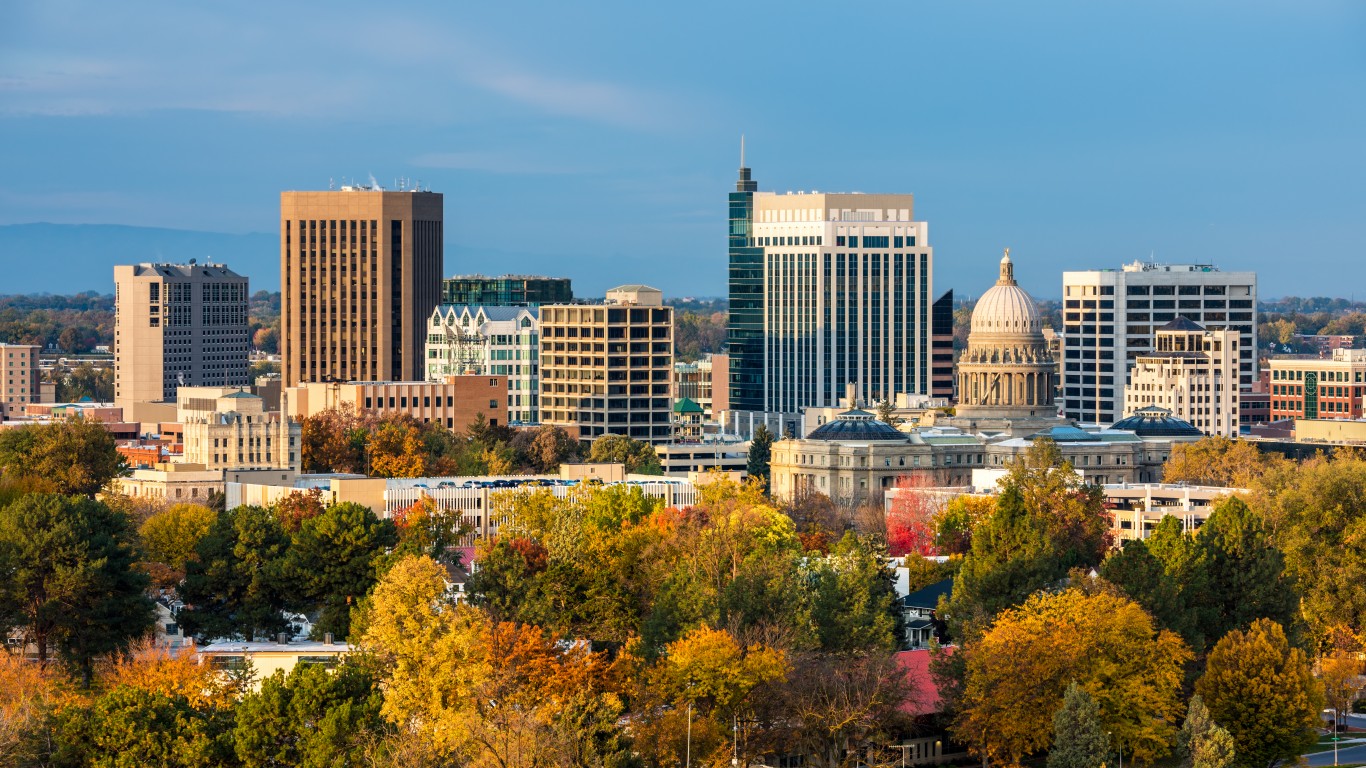
Worst States to Be a Teacher
15. Idaho
> Average teacher pay: $50,111 (8th lowest)
> Student-teacher ratio: 16.9 to 1 (5th highest)
> New teachers expected to qualify for pension: 70.0% (2nd highest)
> Teacher employment: 16,410 (51.1% elementary, 11.1% middle, 37.8% high school)
> High school graduation rate: 80.7% (6th lowest)
With large class sizes, low high school graduation rate, and relatively low salaries, Idaho ranks among the 15 worst states to be a teacher. The student-teacher ratio across the state is almost 17 to 1, fifth highest among states. The average teacher makes about $50,000 a year, significantly less than the national average of almost $65,000 and the eighth lowest annual teacher pay in the country.
Though a large percentage of new teachers are expected to stay in the profession long enough to qualify for a pension, they are not paid much after retiring. The average benefit for new retirees is $20,000, the 10th lowest in the U.S.
[in-text-ad]

14. New Hampshire
> Average teacher pay: $60,288 (22nd highest)
> Student-teacher ratio: 11.2 to 1 (7th lowest)
> New teachers expected to qualify for pension: 31.0% (10th lowest)
> Teacher employment: 14,170 (42.8% elementary, 21.9% middle, 35.3% high school)
> High school graduation rate: 88.8% (11th highest)
The cost of living in New Hampshire is among the 10 highest in the U.S., with prices about 6.0% higher than the national average. After adjusting for the state’s high cost of living, teachers in the state earn about $57,000 annually on average, significantly less than the average teachers’ pay of nearly $65,000 nationwide. The low share of new teachers expected to teach for enough years to qualify for retirement benefits of just 31.0% is also among the lowest, further lowering New Hampshire’s ranking on this list. The pensions of teachers who do end up collecting their benefits in the state are also low at about $19,600, the seventh lowest of all states.
In some parts of the state teachers are getting threats from parents after schools decided to start the new academic year full-time online, according to the state’s largest teachers union.

13. Kansas
> Average teacher pay: $51,674 (12th lowest)
> Student-teacher ratio: 12.8 to 1 (18th lowest)
> New teachers expected to qualify for pension: 45.0% (25th highest)
> Teacher employment: 35,280 (46.3% elementary, 18.8% middle, 34.9% high school)
> High school graduation rate: 87.2% (18th highest)
Though Kansas has a relatively low student-teacher ratio, teachers are paid on average nearly $52,000 annually, significantly less than the national average of almost $65,000. Similarly, though about 45% of new teachers are expected to be teaching long enough to qualify for a pension, the benefit for those who do is among the lowest in the U.S. The average pension is just over $17,000 a year, the fourth lowest in the country.
Many teachers in Kansas, as well as across the U.S., are considering quitting due to safety concerns over having to go back to classrooms during the pandemic, according to media reports. In Kansas, some educators may have to pay as much as $10,000 in fines for resigning.

12. West Virginia
> Average teacher pay: $46,805 (4th lowest)
> Student-teacher ratio: 12.5 to 1 (16th lowest)
> New teachers expected to qualify for pension: 25.0% (5th lowest)
> Teacher employment: 14,950 (35.7% elementary, 34.5% middle, 29.8% high school)
> High school graduation rate: 90.2% (4th highest)
West Virginia’s pension system for teachers does not appear to be serving its beneficiaries particularly well due at least in part to high turnover of teachers. Only one in every four new teachers in the state are expected to remain in the profession long enough to qualify for pension benefits, the fifth lowest proportion of all states.
Additionally, average teachers’ pay in West Virginia is almost $47,000, about $17,000 less than the national average and the fourth lowest amount among all states.
[in-text-ad-2]

11. Alabama
> Average teacher pay: $51,069 (10th lowest)
> Student-teacher ratio: 16.0 to 1 (9th highest)
> New teachers expected to qualify for pension: 39.0% (20th lowest)
> Teacher employment: 49,190 (48.1% elementary, 21.0% middle, 31.0% high school)
> High school graduation rate: 90.0% (5th highest)
Like in many other states where it is relatively difficult to be a teacher, public school teachers in Alabama are not paid especially well compared to their peers nationwide. The average annual pay for teachers is just over $51,000, the 10th lowest in the U.S. After adjusting to the state’s relatively low cost of living, the average annual teacher pay in the state is $59,107, versus the comparable national teacher pay of $64,524. In its annual evaluation of state education policy goals, The NCTQ awarded Alabama an F for its ability to retain effective teachers.
Also like many other of the worst states to be a teacher, Alabama has been dealing with a teacher shortage for several years. To find solutions to the problem, the state Department of Education created in 2019 a task force that recommended better pay and streamlining the process of certifying teachers.

10. Nevada
> Average teacher pay: $57,725 (25th lowest)
> Student-teacher ratio: 18.6 to 1 (3rd highest)
> New teachers expected to qualify for pension: 57.0% (10th highest)
> Teacher employment: 20,240 (51.8% elementary, 19.8% middle, 28.5% high school)
> High school graduation rate: 83.2% (17th lowest)
Smaller classroom sizes have been shown to benefit both students and teachers. Educators who teach smaller classes can focus more on individual students, spend less time handling interruptions, and experience less stress on the job. In Nevada, the student-to-teacher ratio is the third worst of all states.
The NCTQ has given an overall C- grade to the state’s teaching quality policies. Some of the weaknesses the report has identified include lack of support for leadership opportunities and no additional compensation for more experienced teachers. Additionally, Nevada teachers’ average pay, when adjusted to the cost of living, is more than $5,000 lower than the national average.
[in-text-ad]

9. Oregon
> Average teacher pay: $70,630 (9th highest)
> Student-teacher ratio: 18.5 to 1 (4th highest)
> New teachers expected to qualify for pension: 46.0% (24th highest)
> Teacher employment: 31,040 (51.4% elementary, 20.1% middle, 28.5% high school)
> High school graduation rate: 78.7% (4th lowest)
According to the NCTQ, Oregon’s education policies aimed at promoting teacher quality are severely lacking. The state received F grades in three of nine categories and an overall grade of D-. Small classroom sizes have been shown to be beneficial to both the learning experience of students and working conditions of teachers. But Oregon has an average classroom size of about 19 students for every teacher, the fourth largest of all states. Oregon has the fourth lowest high school graduation rate in the nation, at 78.7%.
Despite the fact that the average benefit for retirees in the state is among the highest in the U.S., just 46.0% of new teachers are expected to stay long enough on the job to qualify for a pension, the 24th highest share of all states.

8. Maine
> Average teacher pay: $54,629 (17th lowest)
> Student-teacher ratio: 10.7 to 1 (4th lowest)
> New teachers expected to qualify for pension: 14.0% (2nd lowest)
> Teacher employment: 14,410 (40.1% elementary, 22.4% middle, 37.5% high school)
> High school graduation rate: 86.7% (22nd highest)
Public school teachers in Maine benefit from small classroom sizes, which have been shown to be favorable to both students and teachers. With one of the lowest student-teacher ratios in the nation, the state is an exception on this list of worst states to be a teacher.
One of the factors driving the state’s poor ranking is its failure to provide a retirement system that adequately supports teachers. Only 14% of new teachers in Maine are expected to remain long enough to qualify for pension benefits. Further, teachers in Maine are not permitted to take their benefits to other states. Teachers are also extremely unlikely to receive retirement payments that are equal to their total contributions, and up to 74% of contributions go to debts created by poor state management.
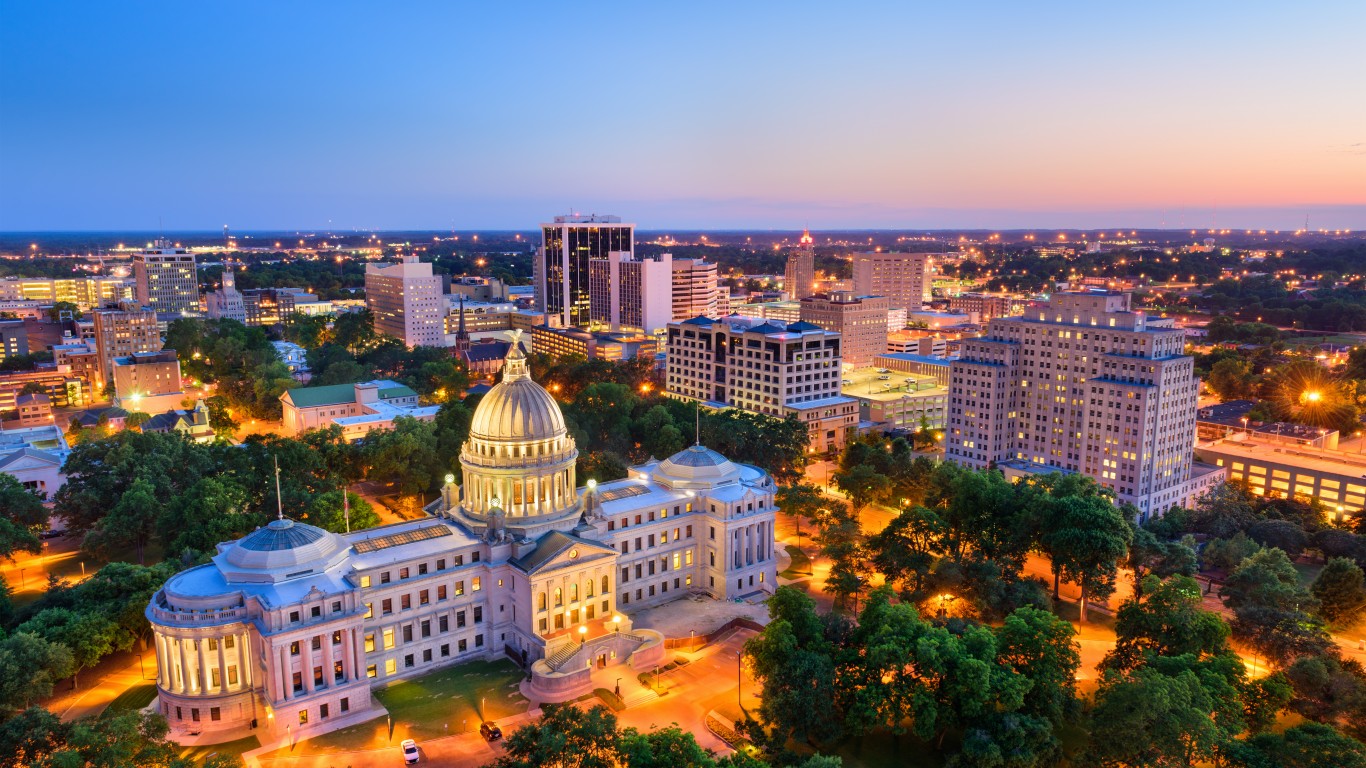
7. Mississippi
> Average teacher pay: $45,803 (2nd lowest)
> Student-teacher ratio: 13.7 to 1 (24th highest)
> New teachers expected to qualify for pension: 22.0% (3rd lowest)
> Teacher employment: 27,370 (45.1% elementary, 22.6% middle, 32.3% high school)
> High school graduation rate: 84.0% (19th lowest)
As is the case in only two other states, less than one-quarter (22%) of new teachers in Mississippi are expected to stay in the profession long enough to qualify for a pension. For those who do end up retiring with benefits, the average pension is $18,927 annually, the sixth lowest of all states. Mississippi has the nation’s second lowest cost of living, with prices on average 14% lower than across the nation as a whole. After adjusting for the low cost of living, however, the state’s average annual salary for teachers jumps to $53,259, but even this figure is the fourth lowest of all states.
The new academic year has begun in Mississippi, and teachers told Mississippi Today that they were spending their own money for cleaning supplies because they were not given enough resources or protections by the state.
[in-text-ad-2]
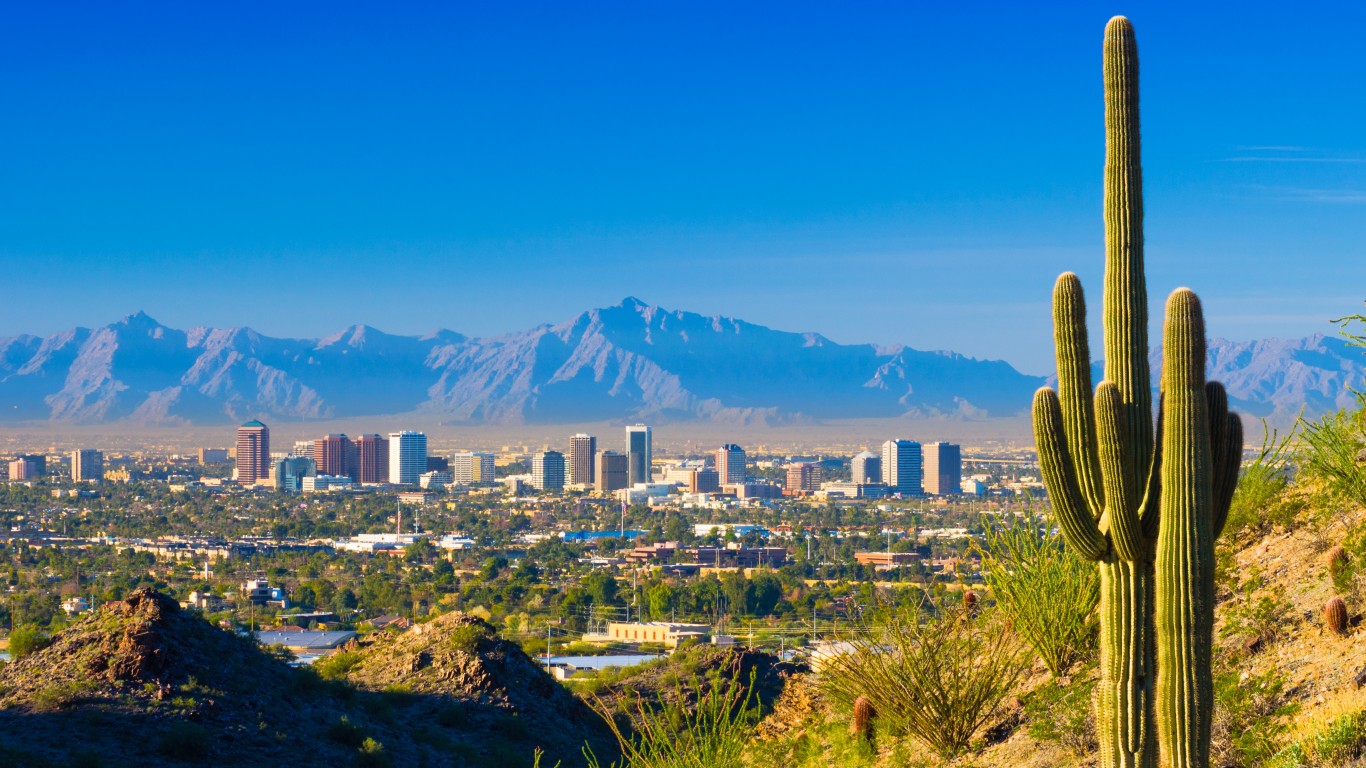
6. Arizona
> Average teacher pay: $47,012 (5th lowest)
> Student-teacher ratio: 21.2 to 1 (2nd highest)
> New teachers expected to qualify for pension: 100.0% (the highest)
> Teacher employment: 52,610 (44.3% elementary, 23.4% middle, 32.3% high school)
> High school graduation rate: 78.7% (4th lowest)
While all new teachers in Arizona are expected to stay in the profession long enough to qualify for retirement benefits, the average annual retirement benefit is the eighth lowest of all states at nearly $20,000. Additionally, large class sizes — with 21 students per every teacher, the second highest teacher-student ratio in the country — only make teachers’ jobs harder and worsen both the learning experience and teachers’ working environment.
Teachers working in Arizona are not very well paid at all. They make $47,012 a year, the fifth lowest annual pay of all states. After adjusting to the cost of living in the state, the average annual teachers pay is nearly $49,000, the lowest among states and well below the national average for teacher’s pay of almost $65,000.

5. Oklahoma
> Average teacher pay: $46,471 (3rd lowest)
> Student-teacher ratio: 14.5 to 1 (15th highest)
> New teachers expected to qualify for pension: 44.0% (25th lowest)
> Teacher employment: 37,980 (47.3% elementary, 21.9% middle, 30.8% high school)
> High school graduation rate: 81.8% (12th lowest)
The average annual pay for teachers in Oklahoma is $46,471, the third lowest of all states. When adjusted to the state’s low cost of living, average teacher pay jumps to $52,568, but is still the third lowest of all states and considerably less than the U.S. average of almost $65,000.
The NCTQ has given a D+ grade for the state’s overall teacher quality, worse than the state’s grade of B- in 2015, 2013, and 2011. Some of Oklahoma’s weaknesses identified in the report include not requiring an elementary or secondary special education certification and not allowing ineffective classroom performance to be grounds for dismissal.
[in-text-ad]

4. Colorado
> Average teacher pay: $55,263 (20th lowest)
> Student-teacher ratio: 15.7 to 1 (12th highest)
> New teachers expected to qualify for pension: 36.0% (17th lowest)
> Teacher employment: 56,300 (45.7% elementary, 23.1% middle, 31.2% high school)
> High school graduation rate: 80.8% (7th lowest)
Like most states that rank among the worst to be a teacher, teachers in Colorado are paid relatively low wages. Teachers earn on average just over $55,000 annually, about $10,000 less than the average teachers pay in all states. And after adjusting to the cost of living, teachers in the state earn the eighth lowest pay in the country.
Though teacher retirees in Colorado receive on average one of the highest retirement benefit amounts, just over a third of new teachers are expected to stay teaching in Colorado to qualify for retirement benefits. This may be partially due to the fairly stricter rules to collect benefits. Teachers can retire at any age after 35 years of teaching or at age 65 after any amount of service, more than the standard of 30 years of teaching and age 58.

3. Hawaii
> Average teacher pay: $63,111 (19th highest)
> Student-teacher ratio: 14.1 to 1 (21st highest)
> New teachers expected to qualify for pension: 25.0% (5th lowest)
> Teacher employment: 12,190 (47.4% elementary, 17.1% middle, 35.4% high school)
> High school graduation rate: 84.5% (21st lowest)
Hawaii has the nation’s highest cost of living, with prices on average 18.1% higher than across the nation as a whole. Adjusted for the high living costs, the state’s average annual salary for teachers is $53,438, the sixth lowest in the country.
Only a quarter of new teachers in Hawaii are expected to remain teachers long enough to qualify for retirement benefits, the fifth lowest share of teachers out of all states. The low retirement benefit for those teachers who do manage to retire of just over $9,000 is the second lowest of all states and may contribute to higher turnover of public school educators.

2. Montana
> Average teacher pay: $53,501 (14th lowest)
> Student-teacher ratio: 12.8 to 1 (17th lowest)
> New teachers expected to qualify for pension: 35.0% (15th lowest)
> Teacher employment: 10,660 (46.2% elementary, 19.4% middle, 34.4% high school)
> High school graduation rate: 86.4% (25th highest)
The NCTQ has given an F grade to the state’s teaching quality policies. Only 35.0% of new teachers are expected to qualify for retirement benefits. When it comes to retaining effective staff, no measures, including supporting teacher leadership opportunities and considering effectiveness during layoffs, are implemented. The report lists no strengths at all in the state’s teaching quality policies.
Additionally, teachers in Montana are paid much less than their peers across the U.S. The average pay for teachers in the state is $53,501, about $11,000 less than the national average and the 14th lowest in the country. The average pay is the 14th lowest also after adjusting to the cost of living.
[in-text-ad-2]
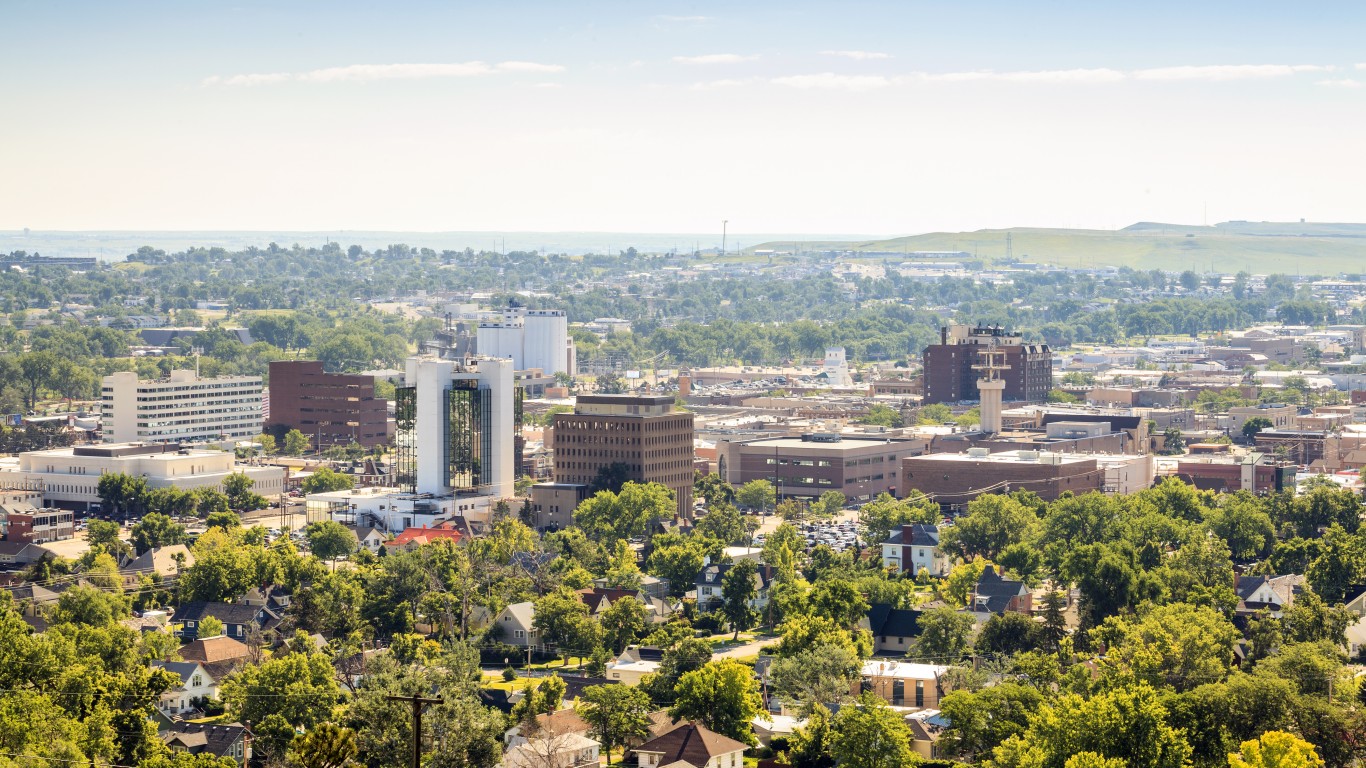
1. South Dakota
> Average teacher pay: $44,472 (the lowest)
> Student-teacher ratio: 12.5 to 1 (15th lowest)
> New teachers expected to qualify for pension: 53.0% (17th highest)
> Teacher employment: 9,490 (42.9% elementary, 20.2% middle, 36.9% high school)
> High school graduation rate: 84.1% (20th lowest)
South Dakota’s teachers’ pay is the lowest of all states and about $20,000 less than the national average. When adjusted to the cost of living, teachers’ pay is the second lowest. Though more than half of new teachers are expected to qualify for employer-based retirement benefits, the state still ranks as the worst state to be a teacher. The average benefit retired teachers receive is the third lowest in the country at just over $16,000 annually.
The NCTQ has given the state’s various policies on making sure teachers are qualified an F, worse than the previous three years when it was awarded a D or D-. The state received a D grade in only three of the nine categories evaluated; the other six had an F grade. The report lists almost no strength to the state’s education system and weakness in just about every section being evaluated.
Methodology
To identify the states where it’s best (and worst) to be a teacher, 24/7 Tempo constructed an index of four measures:
1. Average annual pay for primary, middle, and secondary school teachers from the May 2019 Occupational Employment Statistics (OES) program. We calculated a weighted average for teacher pay for teachers using the percentage of primary, middle, and secondary teacher employment, then adjusted for cost of living using the 2018 Regional Price Parity (RPP) from the Bureau of Economic Analysis. These are the latest years for which this data is available.
2. The student-teacher ratio was calculated using data from the National Center for Education Statistics (NCES) Common Core of Data (CCD) for the 2017-2018 school year. For this calculation, we counted teachers as defined by the CCD as any professional school staff member who instructs students in prekindergarten, K-12, or ungraded classes, and maintains daily student attendance records. Data for teachers are expressed in full-time equivalents (FTE), which is hours worked by one employee on a full-time basis. The total number of students also came from the CCD. Data for public schools include prekindergarten through grade 12. The pupil/teacher ratio includes teachers for students with disabilities and other special teachers. Ratios for public schools reflect totals reported by states and differ from totals reported for schools or school districts. Charter schools are included.
3. The percentage of new teachers who are expected to qualify for a pension came from Teacher Pensions.org and is as of January 2019, the most recent data available. This measure estimates the likelihood a new teacher will leave the profession before being entitled to receive retirement benefits.
4. The overall state education quality grade given to each state by the research and policy group National Council for Teacher Quality’s 2017 bi-annual report.
In addition to these four measures used to create the index and the rank, 24/7 Tempo reviewed a variety of other measures related to education and teachers. The average cohort graduation rate (ACGR) for the 2017-2018 school year is from the NCES. Median household income, poverty rate, and educational attainment are from the American Community Survey 2018 1-Year Estimates, while labor force statistics for 2019 are from the Bureau of Labor Statistics.
Get Ready To Retire (Sponsored)
Start by taking a quick retirement quiz from SmartAsset that will match you with up to 3 financial advisors that serve your area and beyond in 5 minutes, or less.
Each advisor has been vetted by SmartAsset and is held to a fiduciary standard to act in your best interests.
Here’s how it works:
1. Answer SmartAsset advisor match quiz
2. Review your pre-screened matches at your leisure. Check out the advisors’ profiles.
3. Speak with advisors at no cost to you. Have an introductory call on the phone or introduction in person and choose whom to work with in the future
Get started right here.
Thank you for reading! Have some feedback for us?
Contact the 24/7 Wall St. editorial team.
 24/7 Wall St.
24/7 Wall St. 24/7 Wall St.
24/7 Wall St. 24/7 Wall St.
24/7 Wall St.
